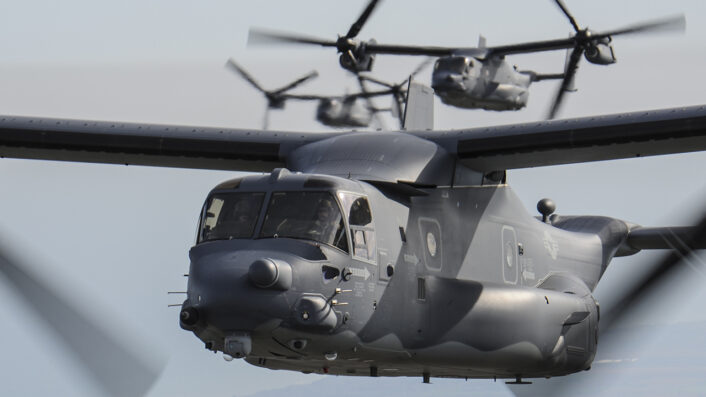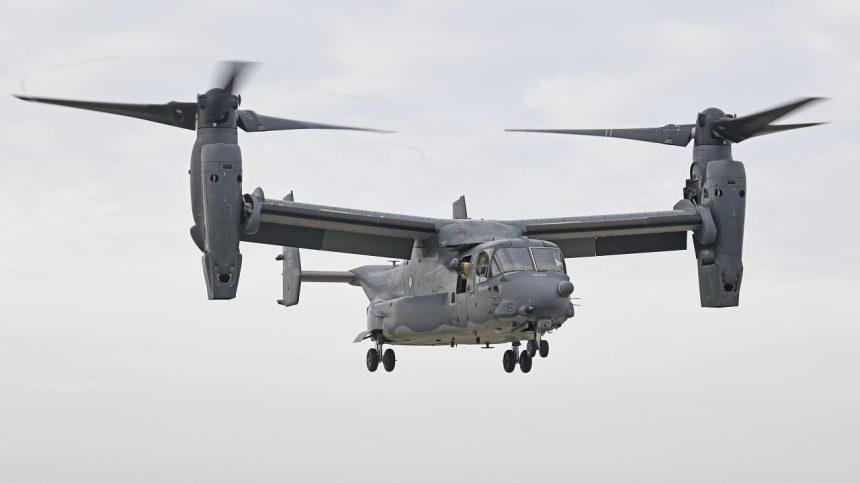The CV-22 deployment would be the first since the 2023 fatal crash and the subsequent limited operations. The MV-22 fire happened on the ground at Fairchild AFB and was quickly extinguished without injuries or damages.
The head of the Air Force Special Operations Command (AFSOC), Lt. Gen. Michael E. Conley, announced that the command will deploy a number of CV-22 Osprey tiltrotor on operations abroad for the first time since last year’s fatal crash in Japan. The info was released during the 2024 Air, Space & Cyber Conference, where Conley spoke with reporters.
In the same hours, an MV-22 of the U.S. Marine Corps experienced an engine fire on the ground at Fairchild Air Force Base, Washington, on Sep. 18, 2024. The personnel safely escaped the aircraft and no injuries or damage were reported.
The CV-22’s new deployment
Almost a year after the fatal crash in Nov. 2023, the Ospreys are still undergoing a phased return to the flight activities, focusing on training. The tiltrotors resumed flying in May, with restrictions requiring the V-22 to operate within 30 minutes of a safe landing zone.
This restriction will reportedly be applied also during the deployment, although it was defined as a “a mission planning issue,” not a flight restriction. A spokeswoman added that this will require planning and deconfliction to be applied to aircraft flying in a combat zone.
A deployment date for the CV-22s was not provided, with Conley only stating it will happen within a few weeks. As for the location, the commander said it will not take place in the Indo-Pacific or European theaters, as they already have permanently stationed CV-22 squadrons (Yokota Air Base, Japan, and RAF Mildenhall, UK).
Conley also provided an update on the status of the Osprey fleet after the resume of the operations and the restrictions. Currently, about 60% of the 51 CV-22s assigned to AFSOC are again fully operational, with the rest to follow by late 2024 or early 2025.
Yokota’s and Mildenhall’s CV-22s “are almost back to full mission readiness. We will deploy out here in the coming weeks, back to support other geographic commanders,” said Conley. “My whole fleet is not operationally running yet, but I have enough capacity and the right crews training to provide the capabilities on the battlefield.”

New safety procedures
The investigation about the crash in Japan found out that it was caused by a “catastrophic failure” of the left-hand proprotor gearbox (PRGB). The report also pointed out at how the crew dealt with multiple PRGB “chip burn” warnings, which were later followed by a chip detector’s fail shortly before the PRGB’s pinion gear completely failed, with the subsequent cascade of malfunctions which caused the left proprotor to stop spinning.
At the time, the checklists mandated the crews to “land as soon as practical” after three chip burns, with the fourth one becoming “land as soon as possible.” These numbers have now been changed to one and two, respectively.
“Our criteria prior was three chip [warnings] was a ‘land as soon as practical,’” said Conley, who also headed the investigation board. “We’ve changed that to one, and then two becomes a ‘land as soon as possible.’ At the end of the day, there will always be aircraft commander and crew discretion. It’s the nature of what we do. The environments are unique, depending on where we fly and what we’re doing, but we have tightened up the guidance to try to make it less ambiguous to the crews up there.”
After four deadly crashes in the last two years, which caused the death of 20 service members, the V-22 has come under intense scrutiny. The reliability of the aircraft and its safety are being questioned, together with the need for the complex tiltrotors.
Because of this, Conley mentioned that AFSOC took a deliberate and safety-conscious approach in the return of the CV-22 to flight operations. “To be blunt about it, I would not put the men and women of AFSOC back on the plane if I wasn’t confident that it could do what we needed it to do,” he said.
The General also spoke about his experience during the investigation, explaining how the safety of the aircrews flying the Osprey is a paramount and a top priority.
“As part of my Accident Investigation Board duties, I spent time with families after the report came out, and that’s hard,” said Conley. “Those families are still grieving, and I appreciate that. They were all gracious to me and my team as we met and spent time with them. I owe it to the families to make sure that we’re giving [Airmen] the safest aircraft we can. And I wouldn’t put them in harm’s way if I didn’t have confidence in it.”

The MV-22 ground fire
Almost at the same time of the announcement of the CV-22’s deployment, photos shared to Facebook on the unofficial Air Force amn/nco/snco page showed fire crews responding to “Osprey on fire at Fairchild AFB.” The photos showed two unidentified V-22s on the ramp, with one being sprayed with a water cannon and later shown covered in foam.
Officials reportedly acknowledged the incident, releasing a statement to local news websites. The Fairchild Fire Department quickly responded to the emergency, which ended without serious consequences.
“An MV-22B Osprey assigned to a visiting detachment from 3rd Marine Aircraft Wing experienced an engine fire while conducting standard operations at Fairchild Air Force Base,” according to a statement from the 92nd Air Refueling Wing and 3rd Marine Aircraft Wing. “Base emergency response capabilities responded quickly and extinguished the fire. No one was injured and no other equipment was damaged. The incident is under investigation.”
It is unknown if the Osprey suffered the engine fire before departing Fairchild or at the return from a training mission. The first photo shows both MV-22s with the engines running, surrounded by the fire department as they deal with the fire, although no flames or smoke were visible.
In case you can’t see the embedded post below, click here.









